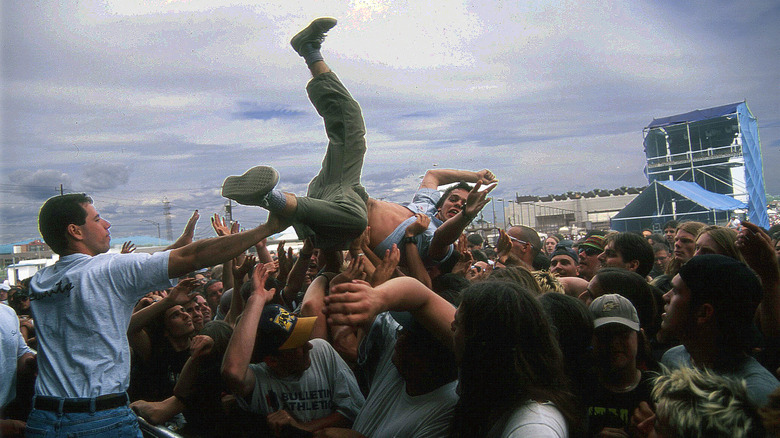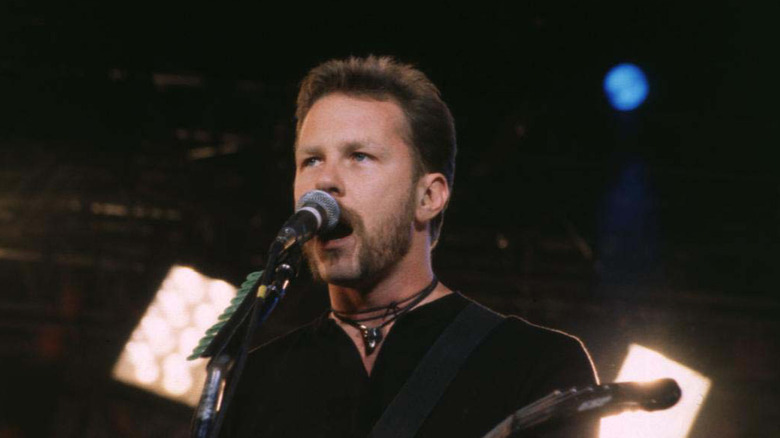What Destroyed Lollapalooza's Popularity In The '90s?
Nothing quite encapsulates the alternative culture boom of the early 1990s like Lollapalooza. The music festival first formed in 1991 as a farewell tour for Jane's Addiction and brought together some of the biggest bands of the era. The 20-city run of the United States and Canada featured Nine Inch Nails, the Henry Rollins Band, and rapper Ice-T's metal outfit Body Count, as well as several other acts and attractions.
Lollapalooza became an instant legend and returned the following year in an expanded form with a second stage. In the years that followed, the tour became a notable platform for the cross-platforming of rock and hip-hop acts, with Snoop Dogg and Ice Cube performing on the same bill as alt-rock acts in a way that audiences hadn't seen before. But as early as 1998, the traveling festival was beginning to struggle, leading to an extended hiatus that lasted until 2003. At the time, Lollapalooza struggled to maintain its identity amid changing tastes, and it faced financial issues that can be fatal for any large-scale event.
A changing musical landscape and fatigue saw Lollapalooza lose its edge
In the early years of Lollapalooza, the event was characterized as belonging to the cutting edge of the decade's music. But the purity of vision that first propelled Jane's Addiction's Perry Farrell to put it together also threatened to destabilize it. Early 1990s alternative rock, particularly grunge, stood in contrast to the hair metal that had dominated the 1980s. With this shift, Farrell was uncomfortable with certain headliners on the bill, such as the macho thrash band Metallica, who performed in 1996. Amid rising ticket prices, some believed the booking represented the death of the alternative scene. Organizers attempted to pivot Lollapalooza in a more electronic direction in 1997, but it reportedly didn't sit well with its hardcore attendees.
At the same time, it seemed that bands began to grow tired of the Lollapalooza tour schedule and its repetitiveness and began to act out. Speaking to NPR, Tom Beaujour, co-author of "Lollapalooza: The Uncensored Story of Alternative Rock's Wildest Festival," told a story that encapsulated this kind of fatigue. "I think the strangest thing that happened was in 1994, when the band L7, who were an all-female punk rock band, teamed up with Nick Cave and the Bad Seeds," he said. "And they were so bored that they decided to create papier-mâché cars and wigs and reenacted the Kennedy assassination ... in Dallas ... That really sort of shows off the kind of bad judgment and cabin fever that can occur when you spend eight weeks on a bus."
Financial pressure and struggles to find a headliner hit hard
It may feel as though today's music festivals are the most lucrative avenue to make profit in a media landscape dominated by streaming and a dearth of physical sales. But the truth is that such events can cost a great deal of money if they are not properly financed. And the same was true back in the 1990s, with Lollapalooza quickly finding itself in financial trouble despite having established itself as an iconic alternative culture institution in just a few short years.
After attracting criticism in both 1996 and 1997, the event struggled to secure big-name acts willing to headline the 1998 incarnation. "Once thought to be an impregnable franchise, the seven-year-old summer festival was unable to secure enough upper-echelon acts to make this year's Lollapalooza road-worthy, so it won't rock out at all," Rolling Stone reported at the time. Among those to turn down slots were Green Day, Garbage, Foo Fighters, Marilyn Manson, Radiohead, and even founding band Jane's Addiction.
It wouldn't return for another five years. However, since 2005, Lollapalooza has enjoyed a long period of stability as a non-touring festival in Chicago. It attracts around 200,000 visitors each year, with franchise events held across the world.


